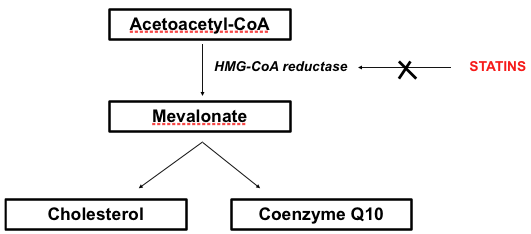Statin drugs (Lipitor®, Zocor®, Pravachol®, Crestor®, and the like) are prescribed to lower a person’s cholesterol level. They do this by inhibiting the body’s internal production of cholesterol (they do not affect the cholesterol that you eat). But what many people do not know is that at the same time, these drugs inhibit the body’s production of coenzyme Q10.1-4 This means there is less coenzyme Q10 and Ubiquinol (the reduced form of CoQ10 – see the post, “What is the Difference Between Coenzyme Q10 and Ubiquinol?” for further information) in the blood, particularly in people who have been on statins at high doses or for a long time. Even small decreases in CoQ10 can disrupt the body’s ability to produce energy and cause other compromises in function. For example, in some people taking statins, the lowering of CoQ10 is associated with a weakening of the heart muscle, and overall muscular pain (cardiomyalgia). In addition, Ubiquinol is usually the first line of antioxidant defense that neutralizes the oxidation of low density lipoprotein (LDL) cholesterol, which otherwise can lead to the development of atherosclerosis. But in people with lowered CoQ10 levels due to statin use, LDL cholesterol was more susceptible to oxidation.5
Let’s look at why this happens.
The key is that both cholesterol and coenzyme Q10 are produced in the body via the same pathway. Take a look at the chart below. You can see that acetoacetyl CoA gets changed into mevalonate. This is done with the help of an enzyme called HMG-CoA reductase. Mevalonate can then be used to make either cholesterol or coenzyme Q10. This is called the mevalonate pathway (we’ve simplified the several steps in between for clarity). Statins work by inhibiting the action of HMG-CoA reductase, so that the amount of mevalonate formed is decreased. Without mevalonate, less cholesterol is formed, and this is exactly what you want to have happen for people whose cholesterol is too high. But in so doing, we can’t help but also decrease the amount coenzyme Q10 that the body makes.

Figure 1. Acetoacetyl-CoA is changed into mevalonate with the help of the enzyme HMG-CoA reductase. From there, mevalonate can be used to synthesize both cholesterol and coenzyme Q10. Statins work by inhibiting the action of HMG-CoA reductase, thereby decreasing the amount of mevalonate available to make either cholesterol or coenzyme Q10.
Numerous studies in humans taking statins have demonstrated that the drugs can lower the amount of coenzyme Q10 in the blood, even in as little as 3 months on standard doses.1,5 Supplementing with Ubiquinol has been shown to increase blood levels of total coenzyme Q10; further research is underway to show how this supplementation can benefit myalgia.
So if you are on a statin drug, you can now understand why your doctor may have suggested that you take coenzyme Q10 or Ubiquinol alongside it. In Canada, statin drug packages include a black box warning recommending that they be taken in conjunction with coenzyme Q10.
- Passi S, Stancato A, Aleo E, Dmitrieva A, Littarru GP. Statins lower plasma and lymphocyte ubiquinol/ubiquinone without affecting other antioxidants and PUFA. Biofactors. 2003;18(1-4):113-24.
- De Pinieux G, Chariot P, Ammi-Said M et al., Lipid-lowering drugs and mitochondrial functions: effects of HMG-CoA reductase inhibitors on serum ubiquinone and blood lactate/pyruvate ratio. Br. J. Clin. Pharmacol. 1996;42(3):333–337.
- Mortensen SA, Leth A, Agner E, Rohde M. Dose-related decrease of serum coenzyme Q10 during treatment with HMG-CoA reductase inhibitors. Mol Aspects Med Suppl 1997;18: S137–144.
- Watts GF, Castellucci C, Rice-Evans C et al., Plasma coenzyme Q (ubiquinone) concentrations in patients treated with simvastatin. J. Clin Pathol. 1993;46(11):1055–1057.
- Hargreaves IP, Duncan AJ, Heales SJ, Land JM. The effect of HMG-CoA reductase inhibitors on coenzyme Q10: possible biochemical/clinical implications. Drug Saf. 2005;28(8):659-76.
